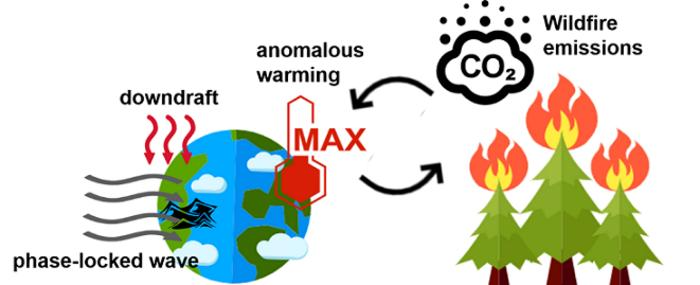Events like wildfires have the potential to affect both human society and ecosystems significantly. The frequency and intensity of wildfires in the Northern Hemisphere have recently increased, something that has become a prominent topic within discussions around climate change.
 The interaction between wildfires and extreme high temperatures. Image Credit: Yihan HU
The interaction between wildfires and extreme high temperatures. Image Credit: Yihan HU
In 2023, Canada witnessed an exceptional wildfire outbreak, with CO2 emissions rising by 527.1% over the 2001-2022 average over May and August. The burned area was almost 6-7 times bigger than in a typical year. Notably, Canada and more than 15 states in the northeastern United States experienced serious air quality disruptions due to this catastrophic occurrence.
Prof. Xu Yue’s study group at Nanjing University of Information Science & Technology in China researched the meteorological factors that caused this devastating occurrence, as well as the potential causes and consequences of wildfires in North America. The results were just published in Atmospheric and Oceanic Science Letters.
This study found a significant association between the prevalence of serious wildfires and anomalies in maximum temperatures.
During periods of high wildfire emissions, maximum temperatures were significantly higher than in periods with low emissions. Conversely, the average precipitation during periods of high wildfire emissions did not exhibit a statistically significant departure from that during periods of low wildfire emissions. Additionally, the phenomenon of ‘rain and wildfires at the same time’ was observed.
Xu Yue, Professor, Nanjing University of Information Science & Technology
Subsequent investigations revealed significant temperature anomalies in the main burn region during the Canadian wildfire eruption period 2023. This occurred along with the persistent existence of anomalous high-pressure systems due to Rossby wave dispersion throughout the region.
As a result of the sustained downdraft, near-surface temperatures continued to rise, creating the ideal environment for wildfires. The extraordinary heatwave event that occurred in North America in 2021 was mostly caused by a similar “phase-locked” occurrence of prolonged geopotential height anomalies.
Yue added, “Owing to the distinctive topographical features of the Rocky Mountains, phase-locked related heat is more prone to occur in west-central Canada, consequently heightening the risk of intensified wildfire events.”
Recurrent and severe wildfires in this area might speed up the warming trend due to the CO2 emissions produced. Concurrently, global warming may enhance the availability of fuel in the future. As a result, additional measures will be required to protect human health and ecological functioning in the affected regions.
Journal Reference:
Hu, Y., et. al. (2024) Climatic drivers of the Canadian wildfire episode in 2023. Atmospheric and Oceanic Science Letters. doi:10.1016/j.aosl.2024.100483